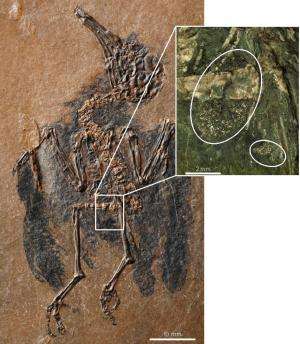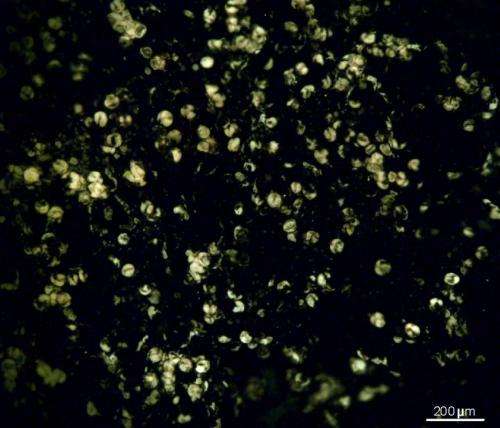May 28, 2014 report
47 million year old bird fossil offers evidence of oldest known pollinator

(Phys.org) —A pair of researchers with Germany's Senckenberg Research Institute and Natural History Museum in Frankfurt has found fossil evidence of a bird that lived approximately 47 million years ago which pollinated plants. The bird (Pumiliornis tessellatus), approximately the size of a modern hummingbird was found in Messel Pit, a well known dig site near Frankfurt. Gerald Mayr and Volker Wilde have documented their discovery in a paper published in the journal Biology Letters.
Scientists have found fossil evidence of insects that pollinated plants (ornithophily) that date back to 100 million years ago, but have struggled to find evidence of birds that did so. Prior to this most recent find, the best evidence researchers had was ancestors of modern humming birds dating back approximately 30 million years ago, and even that evidence was based on assumption as no direct evidence was found that they were actually pollinators. The bird found by Mayr and Wilde leaves little doubt—pollen seeds were found in its stomach. The seeds were also clumped together, which prior research has shown is evidence of pollination by birds.
The find proves that the relationship between birds and flowering plants goes back nearly 50 million years. The researchers report that they actually found two different types of pollen seeds in the belly of the bird, along with nectar and several types of extinct insects. And it wasn't accidental, there were a lot of seeds which indicated the bird was actively seeking them out and ingesting them, which would of course have included incidental pollination. They note also that the bird is not an ancestor of any living species—two others of its kind have been found before, but never with seeds in its stomach.

The researchers note that finding evidence of bird pollination during the middle Eocene suggests that there were plants in existence at the time that were pollinated by birds, though no such fossil evidence of them has ever been found—characteristics such as red coloring or scent, don't fossilize. Because of that, bird fossil finds become more important, and the one in Germany is historic because it's the earliest evidence of any avian species participating in ornithophily.
More information: Eocene fossil is earliest evidence of flower-visiting by birds, Biology Letters, Published 28 May 2014 DOI: 10.1098/rsbl.2014.0223
Abstract
Birds are important pollinators, but the evolutionary history of ornithophily (bird pollination) is poorly known. Here, we report a skeleton of the avian taxon Pumiliornis from the middle Eocene of Messel in Germany with preserved stomach contents containing numerous pollen grains of an eudicotyledonous angiosperm. The skeletal morphology of Pumiliornis is in agreement with this bird having been a, presumably nectarivorous, flower-visitor. It represents the earliest and first direct fossil evidence of flower-visiting by birds and indicates a minimum age of 47 million years for the origin of bird–flower interactions. As Pumiliornis does not belong to any of the modern groups of flower-visiting birds, the origin of ornithophily in some angiosperm lineages may have predated that of their extant avian pollinators.
Journal information: Biology Letters
© 2014 Phys.org




















